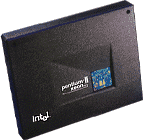Intel's Pentium II Xeon Processor
Introduction
This year 1998 is the year of the Intel processor announcements. After the Pentium II at 100 MHz FSB and the Intel Celeron CPU, June 29 was the day when the Pentium II Xeon was announced, Intel's new high end solution for the workstation and server market. It is now more than a year ago when Intel started replacing the Pentium Pro processor with the Pentium II CPU. The main difference between the two was the speed and location of the second level cache in the CPU as well as the package. The Pentium Pro was never released in a faster version than running at 200 MHz, simply due to the fact that the special L2 cache was not really designed for speeds higher than 200 MHz. In the Pentium Pro you could find a special silicon chip for the L2 cache, which was placed into the same package as the CPU core. This PPro L2 cache was running at CPU clock speed and the limitations for 200 MHz limited the maximal CPU core speed to 200 MHz as well. The Pentium II however was the first Intel CPU delivered in a cartridge, hosting a printed circuit board with the CPU core as well as two or four L2 cache chips. The L2 cache in the Pentium II runs at only half the CPU clock speed, so that 200 MHz L2 cache speed were only reached recently when the Pentium II 400 was released earlier this year.
Whilst the Pentium Pro was replaced by the Pentium II in the high end desktop market pretty quickly, the server market still required the Pentium Pro. There are a few reasons for that. The main problem using a Pentium II in a server system was its initial restriction to 512 MB main memory. Up until quite some time after the release of the Pentium II 333 in the beginning this year, Pentium II CPUs would crash as soon as you supply it with more than 512 MB RAM. Only now the latest 333 MHz versions and the versions at 350 and 400 MHz can run with as much memory as the Pentium Pro uses to run, 4 GB. Powerful servers can easily skip the 512 MB barrier and this barrier was one of the big complaints the server industry had about the Pentium II. The other reason why the Pentium Pro was still very attractive for servers was its second level cache. In servers which run at a very high load, the L2 cache that's dedicated to each of Intel's sixth generation CPUs has a major impact on performance. A larger L2 cache as well as a faster L2 cache are of great benefit here. The Pentium Pro runs the L2 cache at core clock speed, thus faster than any Pentium II up to 350 MHz and the Pentium Pro was available with 512 kB as well as 1 MB L2 cache, whilst the Pentium II is only available with 512 kB L2 cache size. Last but not least, the Pentium Pro could run in dual as well as quad CPU configuration, which can be well required in high end servers, whilst the Pentium II can only run in dual mode, quad or higher is not possible. Now you may understand why the Pentium Pro processor was still on Intel's road map until now, since it was the only feasible high end server solution they provided.
Now things are going to change and Intel's plans are to not only change the situation in the server market place, but also in the workstation area. Workstations are required by people and companies who either do computer animated designing of e.g. cars or houses or bridges, they are required by 3D modelers such as e.g. 3D game developers, the computer animations in movies require some high end workstation performance, so e.g. ILM is using high end workstations and then there are a lot of companies which do evaluations from huge data bases, many of them in the financial field, e.g. at Wall Street. Those companies require workstation performance and so far it was common practice to go with one of the proprietary solutions from Sun, DEC, SGI or Hewlett-Packard. The workstation community is a very conservative one, so that after once getting a product from one of those companies, it was normal to stay with this kind of system. Now we are talking big bucks here. Workstations are not comparable with prices for even high end desktop systems. $20,000 up to $60,000 and more are completely common. Add another $10,000 to more than $100,000 for the software and you know what I am talking about.
Intel's Pentium II Xeon processor is supposed to attack this segment. The Xeon is supposed to deliver workstation performance at a much lower price, you can run x86 workstation software and you can even run your normal office software on the same system too. Thus Intel wants to get big time into the server as well as the workstation market and the Xeon is supposed to make exactly that possible.
Get Tom's Hardware's best news and in-depth reviews, straight to your inbox.
